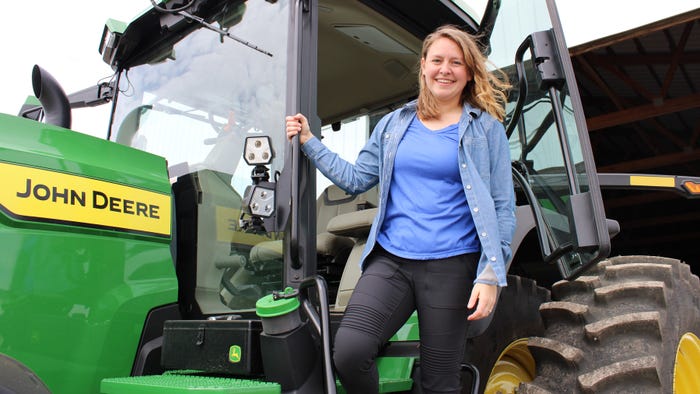April 21, 2023

by Allison Lund
Purdue’s Agronomy Center for Research and Education, also known as the Agronomy Farm, has had time to adjust under new management. Rachel Stevens, farm manager of ACRE, is the third individual to fill that position. She began overseeing operations in April 2021 and has orchestrated the past two growing seasons.
The 1,600-acre farm houses over 200 research projects yearly that are conducted by 80 researchers out of 11 different departments at Purdue. The projects span soil and plant science, weather and climate, and a variety of new and emerging agriculture technologies. Half of the acreage is reserved for research; the other half is designated for rotational acres that help fund the projects.
Stevens and her team are tasked with answering the needs of the research groups and facilitating operations for rotational acres. Some research groups may need more assistance from Stevens, while others work more independently.
“Each researcher has important research that they are doing, and we work hard to help them reach their goals,” Stevens says.
Just like with any other farm, responsibilities are varied. A typical day for Stevens can range from preparing fields for planting in the spring to spraying and applying fertilizers to helping harvest in the fall.
“It’s really a pretty wide variety of things we can approach on any given day,” Stevens says.

ON THE GO: Stevens finds that her various responsibilities keep her moving across the farm’s 1,600 acres.
Now that Stevens is settled into her new position, she shares more about the transition and her work in this interview:
How did you land this position? I am only the third farm manager at ACRE, which started in 1949. When they posted this position, I was really excited because it combines the things I love — farming, getting to look at in-depth research and working with researchers. It seemed really exciting to me to be in a place where you can do some farming and also get to see behind-the-scenes research.
What was the transition into this position like? There was an enormous learning curve. When you start adding in all the details of having 80 different researchers and buildings and equipment, it was just a massive learning curve. But my team of Aaron Kult, Bryan Gretencord and Evan Bossung was incredible at getting me up to speed. A lot of that added pressure fell on them the first year. Things definitely went smoother the second go-around. I’ve seen everything, hopefully; I feel like it comes a lot more naturally.
How do you balance the divide between research and rotational acres? We are geared to do research first; that is our priority as a research farm. But also, we’re very cognizant of the fact that our ability to raise crops on our rotational acres is what keeps the research acres going. It’s a fine line to balance to make sure we’re giving the necessary attention to research acres, but also making sure that we’re not neglecting anything on rotational acres. My team does a fantastic job of prioritizing jobs and being efficient.
How would you assess your first two years? We’ve really tried to build off the foundation that was set here, but we also have the opportunity to implement a new perspective into the operations. We implemented some new soil sampling and soil fertility strategies. We’ve been doing strategic equipment upgrades and have been trying to be a little more reactive to the research needs. We are excited about the direction the farm is headed and the improvements that we’ve made.
What do you hope to achieve moving forward? I would like to maximize research across all our acres. To me, that comes in a couple of different avenues. One is implementing more on-farm research on our rotational acres. The other would be through passive data collection. We’re working really hard to make sure every pass on the field is collecting some amount of useful information that can be used for research and teaching. We’re also really aiming to keep the farm at the front edge of what’s going on in agriculture.

TRACTOR TIME: Stevens and her team spend most of their time completing field operations across the research farm at Purdue.
Rachel Stevens at a glance
Age: 30
Hometown: Stevens grew up in Falls City, Neb., on her family’s row crop farm. Her family still lives and farms in the area.
Education: Stevens attended the University of Nebraska. She received a bachelor’s degree in agronomy and a master’s degree in mechanized systems management with an emphasis on precision agriculture. She finds that her education has made her well-equipped for the work she does at ACRE.
Previous experience: Prior to landing at Purdue’s ACRE, Stevens worked as a crop consultant. In 2019 she started working for a researcher in the Purdue Agronomy Department. She helps with her family farm and her husband’s family farm whenever possible.
Current home: Stevens lives just outside of West Lafayette, Ind. She has called this area home since her move to Indiana in 2019.
Family: Stevens lives with her husband, John, and their dog, Maggie. John works as a professor in the Purdue Agricultural and Biological Engineering Department.
Hobbies: Stevens enjoys gardening, canning, quilting, playing piano and spending time outside. Her favorite hiking spot is the Martell Forest, and she enjoys taking walks there with John and Maggie.
Lund writes from West Lafayette, Ind.
You May Also Like




